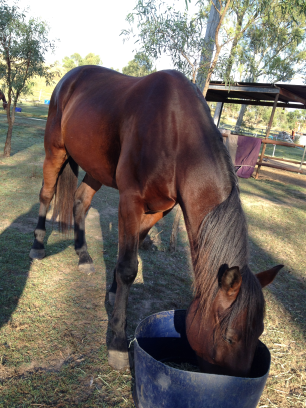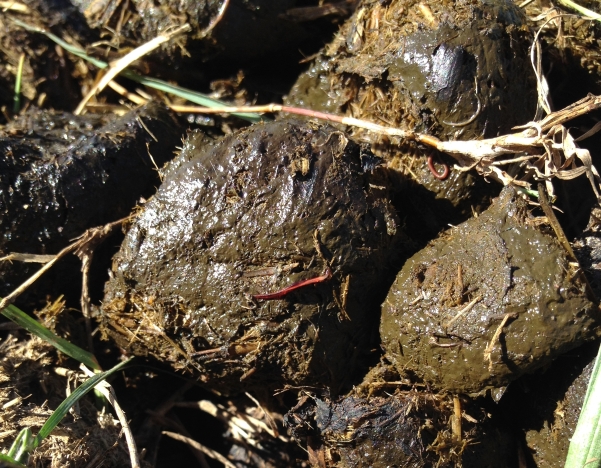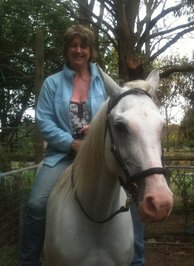From
How to Care for a Rescue Horse: Australian Version
by Dr Ann Nyland
 Note: This information doesn’t only apply to Rescue Horses. Your fat, shiny, “healthy” horse can also die from an overburden of worms with incorrect worming.
Note: This information doesn’t only apply to Rescue Horses. Your fat, shiny, “healthy” horse can also die from an overburden of worms with incorrect worming.
Rescue horses have different needs. Some may be injured, or have wounds, while others may “only” be skinny. Whatever their circumstances, rescue horses need worming and feed, and these two very things, if not carried out correctly, may harm or even kill the horse. This concise and to the point how-to book also takes the reader through several pictorial case histories.
This is an extract from Dr Nyland’s book of the chapter on worming. The full version of this book is available for download at www.smashwords.com
Bear in mind this is an overview, and for full information, please read Dr Nyland’s book What to Worm Your Horse With, Made Easy
The use of the wrong type of a wormer in a horse which is badly infested with certain type of worm leads to a usually fatal condition known as Larval Cyathostomosis. Now please bear with me while I give you the background on this condition, as it is very important in the case of a rescue horse (or any horse with a large quantity of these type of worms).
The net in general, “horse experts” and even some veterinary surgeons recommend deworming based on 1960s and 1970s conditions. In those days, the dangerous horse worm was the large strongyle (Strongylus vulgaris) and so worming treatment targeted this worm. Now that we have ivermectin this worm is no longer a problem, as ivermectin kills both immature and adult stages of this worm. The large strongyle has a long Pre- Patent Period of at least 6 months. A Pre-Patent Period means the time between infection and the first appearance of eggs. This means that once an effective wormer is given on one occasion, a whole Pre-Patent Period needs to run its course before eggs can infect the environment.
The killer worm these days is the small strongyle (cyathostome). This worm requires an entirely different type of treatment than the large strongyle.
Why are they so nasty?
First, let us consider what they do. As little as 6 hours after the horse eats them, they encyst in the intestinal walls. They can stay encysted anything from a few months to a few years. No deworming product except moxidectin (Equest Plus Tape) or fenbendazole (such as Panacur 100 or WSD Fenbendazole) can touch these encysted worms at all – ivermectin cannot do anything to them at all; it is 100% ineffective.
Deworming with a product which is not moxidectin or fenbendazole kills the non encysted small strongyles and they pass out of the horse.
You may think this is good, but in fact it is dangerous if a horse has a large burden of encysted small strongyles.
The reason is that the dewormer kills the non encysted worms, so the horse’s body gives the encysted ones the signal to emerge in large numbers to replace them. As they burst through the lining of the intestine, they bring with them their highly toxic accumulated waste products. The condition this causes is known as Larval Cyathostomosis and in the acute cases is usually fatal. The onset can be rapid. In milder cases, the horse will show colic, loss of appetite, and diarrhea.
Larval Cyathostomosis is often misdiagnosed as gastric ulcers or as eosinophilic enteritis, or even just as “colic.” Unless vets are up with reading the latest academic veterinary articles or attending the latest veterinary conferences, they may be completely unaware of this.
The bottom line is that when a horse who has a lot of encysted cyathostomes is wormed with a standard wormer (that is, a non-moxidectin or non-fenbendazole wormer), the standard wormer kills the small strongyles living in the lumen. (By the way, ivermectin is a standard wormer.) It kills the ones of course that are not encysted as it has zero power to affect the ones that are encysted. The non-encysted worms die and are passed out of the horse.
If there were a lot of small strongyles in the lumen of the horse, and because they have been killed in one go, the encysted small strongyles who have been sitting inside the horse untouched by this standard wormer are given the signal to emerge en masse (bringing with them toxins) to replace the ones that the standard wormer killed.
 In mild cases, this will cause mild colic and /or scouring and /or weight loss, but in horses which have a high burden it will cause serious colic and/or death.
In mild cases, this will cause mild colic and /or scouring and /or weight loss, but in horses which have a high burden it will cause serious colic and/or death.
When they emerge they release toxins from accumulated larval waste products, and this is the problem with these worms. Horses can die when a large number burst through the colon wall and they become sick when a small number burst through. This is known as “Larval Cyathostomosis.”
Again, horses recently dewormed by a wormer such as ivermectin or pyrantel which cannot harm or touch the encysted stages but which does kill the lumen-dwelling larvae and adults, are at risk of Larval Cyathostomosis.
Other contributing factors include seasonal conditions (autumn and winter), young horses (often 6 years of age or younger, although older horses have died from Larval Cyathostomosis),
How to prevent this with your rescue horse? Worm with moxidectin (for example Equest Plus Tape) or a 5-consecutive-day dose of fenbendazole (for example Panacur 100) at the dose rate of 10 mg/kg per day (each day over a 5 day course).
If you do this, not only do you kill a large burden of non-encysted adult small strongyles killed, but you also kill a large burden of the encysted ones who were waiting to replace them. Thus your horse will not get Larval Cyathostomosis.
With rescue horses, I always worm at once, then 2 weeks later worm again, then 2 weeks later, worm again. I use moxidectin or fenbendazole in each case.
DO NOT UNDERDOSE.
WORM IMMEDIATELY.
I do NOT wait until the horse has gained weight to worm them.
Caution! Horses 15 months or younger.
If a young horse who has a huge burden of ascarids (roundworms) is wormed, the ascarids may cause a blockage in the gut and suffer impacted colic. This is why many veterinarians suggest to give a half dose of dewormer initially. However, this is a Catch 22, because a half dose of wormer is likely to cause encysted cyathostomes to migrate, possibly causing Larval Cyathostomosis.
Impacted colic and Larval Cyathostomosis can both be fatal. If you have a young horse and have reason to suspect a heavy burden of ascarids, most parasitologists recommend to give a single dose of fenbendazole (e.g. Panacur 100) at 5 mg/kg. This is, for example, the normal label dose rate in USA but is half the label dose rate in Australia.
A week later, give the 5 day course of Panacur 100 at 10 mg/kg (this is the normal Australian label dose) – do this for 5 consecutive days. If however, you get a huge amount of ascarids in the droppings, it would be sensible to give another single dose a week later of fenbendazole (Panacur 100 or WSD Fenbendazole) at 5 mg/kg and then wait a week for the 5 day dose at 10 mg/kg, and this is the dose that will deal with the encysted cyathostomes.
Bear in mind you will still need to give ivermectin fairly soon to kill the migrating stages of ascarids, or moxidectin (Equest Plus Tape) if the horse is over 6 months of age.
It is important to note that the reason that some veterinarians advise to give a half (or smaller) dose of wormer to an emaciated horse is FOR YOUNG HORSES ONLY, due to the danger of ascarids being impacted in the gut. Unfortunately, some recommend that a half dose be given to older horses, which not only is pointless, as older horses do develop immunity to ascarids, but is also inviting Larval Cyathostomosis. In a nutshell:
1) Fecal egg counts CANNOT tell you ANYHING about encysted cyathostomes because encysted cyathostomes DO NOT LAY EGGS. A horse can have a massive burden of these worms and return a zero fecal egg count.
2) The killer worm today is the small strongyle. Huge numbers of vets, websites, and horse owners are blissfully unaware of this scientific fact, and still worm for the regimes aimed at problem worm decades ago.
3) Encysted small strongyles cannot be affected in any way by any dewormer other than moxidectin (Equest Plus Tape) or fenbendazole (five consecutive day dose of Panacur 100 or WSD Fenbendazole). You could worm until you were blue in the face with abamectin, ivermectin, pyrantel and so on, and the encysted small strongyles would not even notice.
4) If you worm with abamectin, ivermectin, pyrantel and so on and your horse has a heavy burden of encysted small strongyles, you are risking Larval Cyathostomosis as it is a non-contentious, scientific fact that worming with one of these dewormers is the main cause of Larval Cyathostomosis.
5) The ONLY worming products that can kill stages of encysted small strongyles are moxidectin (Equest Plus Tape) or a 5 day consecutive dose of fenbendazole (Panacur 100 or WSD Fenbendazole).
6) Do NOT underdose.
If your rescue horse is very debilitated, you may feel more comfortable giving Panacur 100 (or WSD Fenbendazole). I myself have always given Equest Plus Tape with no problems.
Be careful in foals however. Different countries have different recommendations for the age a foal can be given moxidectin. Use Panacur 100 (or WSD Fenbendazole) in the case of younger foals.
Also be careful with miniature horses. You need to get the dosage right. If you google, you will find good horse weight calculators.
Bear in mind this was an overview, and for full information, please read Dr Nyland’s book What to Worm Your Horse With, Made Easy.
About the Author:
Dr Ann Nyland is an ancient language scholar and lexicographer as well as horse care researcher who served as faculty at the University of New England, Australia.
Ann is best known as researcher and author of the Kikkuli Method, principal of Hyksos Arabians, and an accomplished endurance rider.




